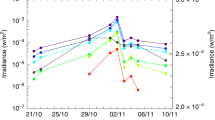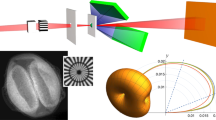Abstract
ON December 17, 1964, at 03 h 35 m U.T. the firing of the second, three-axis stabilized Skylark research rocket occurred at Woomera. It carried an X-ray pinhole camera, a second version of the apparatus which produced the soft X-ray image of the Sun discussed in an earlier communication1. Part of the negative obtained from this flight is reproduced in Fig. 1. Table 1 gives details of the filters and the pinholes used to obtain these images.
This is a preview of subscription content, access via your institution
Access options
Subscribe to this journal
Receive 51 print issues and online access
$199.00 per year
only $3.90 per issue
Buy this article
- Purchase on Springer Link
- Instant access to full article PDF
Prices may be subject to local taxes which are calculated during checkout
Similar content being viewed by others
References
Russell, P. C., Nature, 205, 684 (1965).
Author information
Authors and Affiliations
Rights and permissions
About this article
Cite this article
RUSSELL, P. Further Soft X-ray Images of the Sun. Nature 206, 281–282 (1965). https://doi.org/10.1038/206281a0
Issue Date:
DOI: https://doi.org/10.1038/206281a0
This article is cited by
-
Solar photography in the extreme ultraviolet
Solar Physics (1969)
-
Systematic photometry of XUV solar images
Solar Physics (1969)
-
Improved Resolution X-ray Photographs of the Sun
Nature (1966)
-
Ionosphere, and X-ray Images of the Sun
Nature (1965)
Comments
By submitting a comment you agree to abide by our Terms and Community Guidelines. If you find something abusive or that does not comply with our terms or guidelines please flag it as inappropriate.



